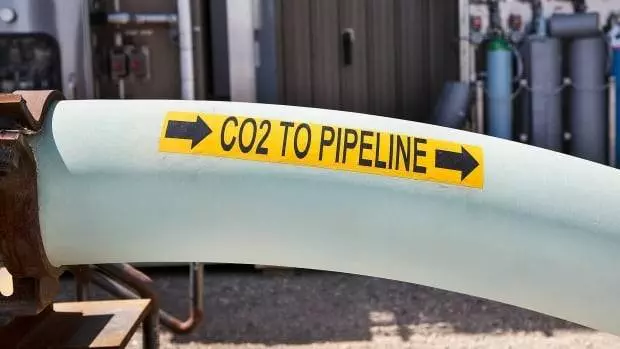Technology tamfitronics
Shell Canada has announced it will forge ahead with a pair of carbon capture projects in Alberta, as recent setbacks for other proposed projects in the sector cast doubt on the technology.
Both projects expected to begin operations toward the end of 2028, company says

Wallis Snowdon · CBC News
·

Shell Canada has announced it will forge ahead with a pair of carbon capture projects in Alberta, after recent setbacks for other proposed projects in the sector have cast doubt on the technology.
The Calgary-based operator said Wednesday it has made a final investment decision for its Polaris carbon capture project at its Scotford refinery and chemicals complex near Fort Saskatchewan.
Shell has also given the green light to proceed with the Atlas Carbon Storage Hub, in 50/50 partnership with Atco EnPower. The first phase of Atlas will permanently store carbon dioxide captured by the Polaris project, which was first proposed in 2021.
Wednesday’s announcement comes amid uncertainty about the financial viability of carbon capture and storage (CCS) technology, which traps carbon emissions at their source and funnels them deep underground.
The technology is expected to play a key role in Canada’s climate plan, but implementing it has proved tricky.
Other CCS projects across the country have been shelved, cancelled or continue to fall short of operational targets, despite significant investment from Ottawa and provincial governments.
The Polaris project is designed to capture about 650,000 tonnes of carbon dioxide annually from the Scotford complex. That works out to approximately 40 per cent of Scotford’s direct CO2 emissions from the refinery and 22 per cent of its emissions from the chemicals complex.
A future phase of the Atlas hub, which could potentially store carbon for Shell, Atco and other companies, remains subject to a future investment decision.
Polaris and the first phase of Atlas are expected to begin operations toward the end of 2028 and will aid Canada meet its emission targets, company officials said. Shell has not disclosed anticipated costs of either project.
Shell Canada president Susannah Pierce said the company has the experience and the financial backing necessary to make the projects successful, even as other companies give up on their carbon capture proposals.
Pierce said every project is different, but in Shell’s case, Polaris is a “key piece” of the company’s overall decarbonization strategy.
She said the recent approval of the federal carbon capture sequestration tax credit — meant to help jump-start carbon capture projects— was also key in their decision to proceed.
“It is now a place in time where we feel like we have the right fiscal incentives,” Pierce said in an interview Wednesday.
“We have greater certainty about the project. We’ve done additional design and engineering. And we’re quite excited to move forward with it because we see it as a critical technology to help us to decarbonize our own Scotford facility.
“And we certainly believe that it’s a critical technology that’s necessary to meet Paris commitments.”

Pierce said the projects will build on the success of its Quest CCS operation at Scotford. Shell developed the $1.35-billion Quest project with the help of $745 million from the Alberta government and $120 million from Ottawa.
Emissions captured by Polaris will be sent to the Atlas Hub via a 22-kilometre pipeline to two storage wells.
CO2 will be stored there approximately two kilometres underground in the Basal Cambrian Sands, the same formation of underground sandstone used to store CO2 from the Quest CCS facility.
Key to climate change targets
Carbon capture, utilization and storage has become a key plank of the Canadian oil and gas sector’s decarbonization goals.
The climate plan estimates carbon capture will account for up to 16 million tonnes of emissions reductions by 2030, or about five per cent of the additional emissions reductions needed to meet the next target in 2030.
Critics, however, have repeatedly cautioned that Canada’s targets should not hinge on a technology that continues to face serious setbacks.
Edmonton-based Capital Power Corp. recently pulled the plug on its plans to build a $2.4-billion CCS project at its Genesee natural gas-fired power plant southwest of Edmonton, announcing the project was no longer financially feasible.
A CCS project at Sask Power’s Boundary Dam has continued to miss its emission targets. An independent report recently declared the operation an “underperforming failure” after nine years in operation and $1 billion spent on the technology. “
Shell’s Quest project has stored nine million tonnes of CO2 at a lower-than-anticipated cost since it became operational in 2015. But its capture rate of 77 per cent remains below the 90 per cent originally announced.
A recent report from the International Energy Agency said oil and gas companies need to start “letting go of the illusion” that “implausibly large” amounts of carbon capture are the solution to the global climate crisis.
‘There will be more’
Pierce said the investment climate is changing. She said Alberta is on the cusp of a string of renewed investments in carbon capture operations.
An increase in government subsidies and the proximity of the Basal Cambrian Sands, the sandstone formation where carbon can be trapped, gives the province an advantage in becoming a leader in implementation of the technology, she said.
“I think the right prerequisites are coming into place,” she said. “This may be the first [project] of this scale that’s moving forward in the province today, but there will be more.”
In a report Wednesday, global consultancy Wood Mackenzie said it projects carbon capture and storage will represent a $196-billion US investment opportunity worldwide over the next decade.
About 70 per cent of that investment will take place in North America and Europe, Wood Mackenzie said.
“The expected pace of … deployment will be driven by the level of regulation and support in different countries,” the report said, adding the U.S. and Canada have “robust” regulatory and funding mechanisms in place to drive implementation.
Technology tamfitronics ABOUT THE AUTHOR

Wallis Snowdon is a journalist with CBC Edmonton focused on bringing stories to the website and the airwaves. Originally from New Brunswick, Wallis has reported in communities across Canada, from Halifax to Fort McMurray. She previously worked as a digital and current affairs producer with CBC Radio in Edmonton. Share your stories with Wallis at [email protected].
With files from Kyle Bakx and The Canadian Press



